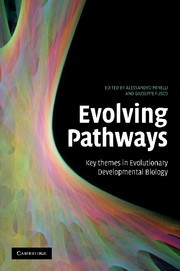Book contents
- Frontmatter
- Contents
- Contributors
- Preface
- Introduction: Pathways of change
- Part I Thinking about evolution by taking development on board
- Part II Evo-devo: methods and materials
- 7 A pragmatic approach for selecting evo-devo model species in amniotes
- 8 On comparisons and causes in evolutionary developmental biology
- 9 Evolution and development: towards a synthesis of macro- and micro-evolution with ecology
- 10 When is a Hox gene not a Hox gene? The importance of gene nomenclature
- 11 Plants are used to having identity crises
- Part III Evolving diversity
- Part IV Evolving body features
- Index
- References
11 - Plants are used to having identity crises
Published online by Cambridge University Press: 08 August 2009
- Frontmatter
- Contents
- Contributors
- Preface
- Introduction: Pathways of change
- Part I Thinking about evolution by taking development on board
- Part II Evo-devo: methods and materials
- 7 A pragmatic approach for selecting evo-devo model species in amniotes
- 8 On comparisons and causes in evolutionary developmental biology
- 9 Evolution and development: towards a synthesis of macro- and micro-evolution with ecology
- 10 When is a Hox gene not a Hox gene? The importance of gene nomenclature
- 11 Plants are used to having identity crises
- Part III Evolving diversity
- Part IV Evolving body features
- Index
- References
Summary
Macroscopic nature is never really anomalous. Abnormalities, like other exceptional cases, at least show incontestably, what the plants can do.
Arber 1950: 6However, regardless of how much faith one has in anatomical definitions, they should not be taken as more than a means of communication prior to subsequent genetic analysis.
Scheres et al. 1996: 963Truth, except as a figure of speech, does not exist in empirical science.
Brower 2000: 18INTRODUCTION
Our green and living world is a continuum in space and time. This view is well expressed in the ‘continuum model’ proposed by botanists and biophilosophers such as Arber (1950) and Sattler (1996). As an opposite view we may accept the green world around us as consisting of discrete units on several hierarchical levels. This view is called here the ‘discontinuum model’ or the ‘classical model’ because it has been the predominant view in biological textbooks for decades. Branching and repetition of developmental units (e.g. cells, meristems, modules, leaves, phytomers) are omnipresent as developmental processes in multicellular plants. These processes resemble the process of segmentation in various metazoan phyla, also occasionally leading to fuzzy borderlines between consecutive developmental units (Minelli and Fusco 2004, Prusinkiewicz 2004, Rutishauser and Moline 2005). Perspectivists studying plants accept structural and developmental categories such as cells, meristems, modules, leaves and phytomers as mind-born, simplified concepts reflecting certain aspects of the structural diversity (Sattler and Rutishauser 1990, Hay and Mabberley 1994).
- Type
- Chapter
- Information
- Evolving PathwaysKey Themes in Evolutionary Developmental Biology, pp. 194 - 214Publisher: Cambridge University PressPrint publication year: 2008
References
- 11
- Cited by

